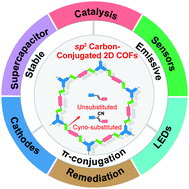sp2 carbon-conjugated covalent organic frameworks: synthesis, properties, and applications
Abstract
Covalent organic frameworks (COFs) represent an emerging class of well-ordered porous materials that precisely reticulate organic units into extended networks and have been at the forefront of porous materials research over the past decade. In the quest to expand the reticular chemistry and develop next-generation COFs with peculiar material properties, sp2 carbon-conjugated COFs (sp2c-COFs) have garnered a surge of interest since their inception in 2016 due to the unparalleled features of continuous π-conjugation, high crystallinity, permanent porosity, unique optoelectronic properties, and extraordinary chemical stability. A rapidly growing number of 2D sp2c-COFs (more than 40 in total within just 4 years) have been hitherto constructed and broadly used in various areas. In this review, we scrutinize the design principles, synthetic routes, key features, and mechanistic investigations of sp2c-COFs. We survey the advances in their broad applications spanning heterogeneous catalysis, radionuclide sequestration, lithium-ion batteries, supercapacitors, and optical applications, and rationalize their superior performance against structurally analogous imine-linked COFs. We further discuss the unsettled scientific challenges and provide future perspectives of sp2c-COFs.



 Please wait while we load your content...
Please wait while we load your content...